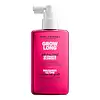What's inside
What's inside
 Key Ingredients
Key Ingredients

 Benefits
Benefits

 Concerns
Concerns

No concerns
 Ingredients Side-by-side
Ingredients Side-by-side

Water
Skin ConditioningPolysorbate 20
EmulsifyingCaffeine
Skin ConditioningBiotin
AntiseborrhoeicRosmarinus Officinalis Leaf Extract
AntimicrobialPanax Ginseng Root Extract
EmollientGlycerin
HumectantPanthenol
Skin ConditioningTocopheryl Acetate
AntioxidantDipropylene Glycol
HumectantSilicone Quaternium-8
Trideceth-10
CleansingCaprylyl Glycol
EmollientPolysilicone-29
Ethylhexylglycerin
Skin ConditioningPhenoxyethanol
PreservativeParfum
MaskingHexamethylindanopyran
MaskingLinalyl Acetate
MaskingLinalool
PerfumingCitronellol
PerfumingBenzyl Salicylate
PerfumingHydroxycitronellal
PerfumingTrimethylbenzenepropanol
MaskingWater, Polysorbate 20, Caffeine, Biotin, Rosmarinus Officinalis Leaf Extract, Panax Ginseng Root Extract, Glycerin, Panthenol, Tocopheryl Acetate, Dipropylene Glycol, Silicone Quaternium-8, Trideceth-10, Caprylyl Glycol, Polysilicone-29, Ethylhexylglycerin, Phenoxyethanol, Parfum, Hexamethylindanopyran, Linalyl Acetate, Linalool, Citronellol, Benzyl Salicylate, Hydroxycitronellal, Trimethylbenzenepropanol
Water
Skin ConditioningDipropylene Glycol
HumectantPolysilicone-29
Vp/Methacrylamide/Vinyl Imidazole Copolymer
Silicone Quaternium-18
EmollientGlycerin
HumectantTrideceth-6
EmulsifyingChamomilla Recutita Flower Extract
MaskingCalendula Officinalis Flower Extract
MaskingPolyimide-1
Potassium Sorbate
PreservativePhenoxyethanol
PreservativeTrideceth-12
EmulsifyingSodium Benzoate
MaskingChlorphenesin
AntimicrobialPotassium Benzoate
PreservativePhenylpropanol
MaskingDisodium EDTA
Propanediol
SolventCaprylyl Glycol
EmollientTocopherol
AntioxidantCitric Acid
BufferingWater, Dipropylene Glycol, Polysilicone-29, Vp/Methacrylamide/Vinyl Imidazole Copolymer, Silicone Quaternium-18, Glycerin, Trideceth-6, Chamomilla Recutita Flower Extract, Calendula Officinalis Flower Extract, Polyimide-1, Potassium Sorbate, Phenoxyethanol, Trideceth-12, Sodium Benzoate, Chlorphenesin, Potassium Benzoate, Phenylpropanol, Disodium EDTA, Propanediol, Caprylyl Glycol, Tocopherol, Citric Acid
 Reviews
Reviews

Ingredients Explained
These ingredients are found in both products.
Ingredients higher up in an ingredient list are typically present in a larger amount.
Caprylyl Glycol is a humectant and emollient, meaning it attracts and preserves moisture.
It is a common ingredient in many products, especially those designed to hydrate skin. The primary benefits are retaining moisture, skin softening, and promoting a healthy skin barrier.
Though Caprylyl Glycol is an alcohol derived from fatty acids, it is not the kind that can dry out skin.
This ingredient is also used as a preservative to extend the life of products. It has slight antimicrobial properties.
Learn more about Caprylyl GlycolDipropylene Glycol is a synthetically created humectant, stabilizer, and solvent.
This ingredient helps:
Dipropylene glycol is technically an alcohol, but it belongs to the glycol family (often considered part of the ‘good’ alcohols). This means it is hydrating and gentle on skin unlike drying solvent alcohols like denatured alcohol.
As a masking agent, Dipropylene Glycol can be used to cover the smell of other ingredients. However, it does not have a scent.
Studies show Dipropylene Glycol is considered safe to use in skincare.
Learn more about Dipropylene GlycolGlycerin is already naturally found in your skin. It helps moisturize and protect your skin.
A study from 2016 found glycerin to be more effective as a humectant than AHAs and hyaluronic acid.
As a humectant, it helps the skin stay hydrated by pulling moisture to your skin. The low molecular weight of glycerin allows it to pull moisture into the deeper layers of your skin.
Hydrated skin improves your skin barrier; Your skin barrier helps protect against irritants and bacteria.
Glycerin has also been found to have antimicrobial and antiviral properties. Due to these properties, glycerin is often used in wound and burn treatments.
In cosmetics, glycerin is usually derived from plants such as soybean or palm. However, it can also be sourced from animals, such as tallow or animal fat.
This ingredient is organic, colorless, odorless, and non-toxic.
Glycerin is the name for this ingredient in American English. British English uses Glycerol/Glycerine.
Learn more about GlycerinPhenoxyethanol is a preservative that has germicide, antimicrobial, and aromatic properties. Studies show that phenoxyethanol can prevent microbial growth. By itself, it has a scent that is similar to that of a rose.
It's often used in formulations along with Caprylyl Glycol to preserve the shelf life of products.
Polysilicone-29 is a complex silicone polymer. It is also known as Silsoft™ CLX-E.
The manufacturer states this ingredient is a conditioning agent for hair care. The website states this ingredient can help hydrate and repair hair.
It is made up of glycidoxypropyl-terminated dimethyl siloxane polymer, peg-13 diglycidyl ether, diethylaminopropylamine, and aminopropyltriisopropoxysilane.
Learn more about Polysilicone-29Water. It's the most common cosmetic ingredient of all. You'll usually see it at the top of ingredient lists, meaning that it makes up the largest part of the product.
So why is it so popular? Water most often acts as a solvent - this means that it helps dissolve other ingredients into the formulation.
You'll also recognize water as that liquid we all need to stay alive. If you see this, drink a glass of water. Stay hydrated!
Learn more about Water